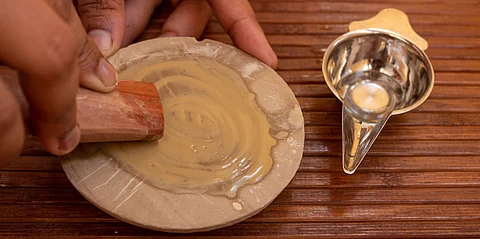

The High Court of Karnataka has directed the state forest department to prepare ‘detailed guidelines’ for evaluating sandalwood prices so that competent authorities can award appropriate compensation.
The order was delivered in the backdrop of the high court hearing writ petitions about the valuation of sandalwood trees coming in the way of lands acquired by the central and state authorities for development purposes.
These lands were acquired from Kadur and Tarikere taluks (subdistricts) of Chikkamagaluru district and another from Srinivasapura taluk in Kolar district.
Sandalwood, an evergreen tree, is a parasitic plant whose roots intertwine with the roots of host plant species without harming them. The heartwood of the sandalwood tree holds high value in the commercial market and is one of the costliest woods in the world.
The heartwood is used to extract oil to make perfumes, or the wood is used to make furniture, carvings and other products. The tree requires about 15-20 years to mature. The sandalwood format starts appearing around the age of 9-10 years, according to researchers.
The petitioners had approached the court in 2017 as the national and state highway authorities had only offered compensation for the land, but not their sandalwood tree plantations. As per the petitions, the aggrieved expected to earn over Rs one crore by harvesting the trees and expected the same in terms of compensation. However, the authorities denied compensation after the forest department admitted there was no guideline value to determine the price of the sandalwood trees that were aged 6-9 years.
The forest department values sandalwood trees on the basis of heartwood formation after the harvest, which ideally is recommended after at least 15 years.
Vivek Subba Reddy, on behalf of the petitioners, submitted: “The competent authority had totally ignored the potential that the sandalwood trees had over the long term and had blindly followed the order passed by the Principal Chief Conservator of Forests (PCCF), who also did not consider the huge potential that the trees had.”
The petitioners said the forest department should have followed the values determined by Karnataka Soaps and Detergent Limited (KSDL) which follows the heartwood formation.
Advocate general Bhanuprakash and other counsel argued that the valuation made by the PCCF were to be accepted as no heartwood formation occurs in trees for the first 10 years and the real value would only materialise after 15 years of maturity.
“The claim of the petitioners that the sandalwood trees would fetch a great value in the future was only speculative and the probability of the trees surviving, including being felled by robbers, was a definite possibility and hence based on such speculative claims, their arguments cannot be accepted,” the counsel argued.
However, the high court observed that the competent authority did not evaluate sandalwood trees while providing the compensation.
The court said, “The potential of having an earning from raising sandalwood trees has been calculated and estimated by the (forest) department itself, which is the domain expert in relation to the valuation of trees, especially sandalwood trees, and it cannot therefore be denied that a sandalwood tree has definite potential to earn a lucrative earning for the person who raises it.”
The division bench held that the petitioners were entitled to compensation for their sandalwood trees and directed the competent authorities to assess and consider the claim of the land loser with regard to the value of sandalwood.
“It is no doubt true that the value of sandalwood is determined by the forest department but this determination of the value of sandalwood is on the basis of the heartwood available in sandalwood trees which have been felled after they are more than 15-20 years old. But the value of a sandalwood tree, which is yet to possess heartwood — the true intrinsic value of a sandalwood tree — is incapable of determination by experts in the field,” the court said.
It stated that with respect to sandalwood trees, the long gestation period to retrieve the yield to its potential has to be taken into consideration.
Citing an analogy, the court said, “When land is acquired for potential use to form plots, its proximity to developed areas or towns is the criterion used by the courts to determine its value and the same is taken into consideration for evaluating the compensation payable. Thus, it would be necessary to assess the potential value that a sandalwood tree may yield.”
While the court issued directives for the compensation to be provided to the aggrieved petitioners by the authorities, it further directed the PCCF to prepare detailed guidelines and notify the prices of sandalwood prevailing every year that will enable the competent authorities to award compensation to the land loser.
The court directed the guidelines to be prepared within two months from the date of receipt of the certified copy of the order passed on January 29, 2025.